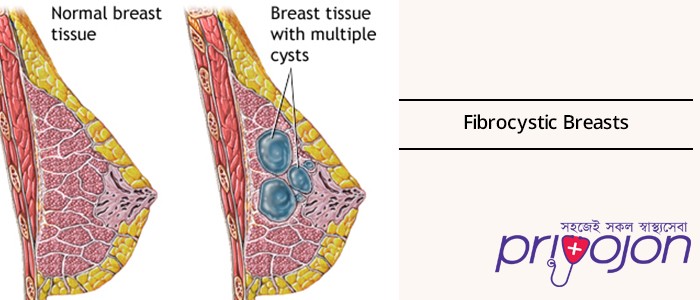
Overview
Medically reviewed by Dr. Rabeya Afroz Shomi
What is the treatment?
How is that the treatment done?
Who is eligible for the treatment?
Who isn't eligible for the treatment?
Are there any side effects?
What are the post-treatment guidelines?
What are the alternatives to the treatment?
What is the treatment?
Mammary dysplasia; Diffuse cystic mastopathy; Benign breast disease; Glandular breast changes; Cystic changes; Chronic cystic mastitis; Breast lump - fibrocystic
How is that the treatment done?
A condition diagnostic painful and lumpy breasts, fibrocystic breast disease may be a condition causing symptoms like tenderness and discomfort of the breasts normally during premenstrual periods, lumpy masses within the breasts which are often asymptomatic and sudden appearance and disappearance of benign masses within the breasts, pain and discomfort under the arms. Usually a fibrocystic breast condition doesn't require invasive treatment and it can get healed either on its own or could also be rectified with the assistance of some useful home remedies. But there are often a threat of carcinoma development if the symptoms aggravate. So, if there are not any symptoms or mild symptoms, no treatment is required . For relief of symptoms your healthcare practitioner can recommend you some self-care measures like taking over-the-counter medicines, oral contraceptives, or putting on a well fitting or a sports bra or applying hot and cold compression on the breasts. A surgery is typically never recommended or finished treating fibrocystic breast disease. just in case there's a cyst within the breast it can sometimes be treated by puncturing and draining it. Some lifestyle changes also are helpful in treating the symptoms. In certain cases where there are enlarged and painful cysts, treatment options could also be warranted like fine-needle aspiration and surgical excision.
Who is eligible for the treatment?
Treatments that include over-the-counter pain relievers like acetaminophen (Tylenol) and ibuprofane (Advil) effectively relieve discomfort and pain during a fibrocystic breast condition. In certain cases doctors can treat severe symptoms with tamoxifen which may be a drug utilized in treating carcinoma or oral contraceptives. Also you'll be advised to require a diuretic which may help drain the fluid (fluid within the fibrocystic breasts too) from the body. Treatment of fibrocystic breasts can include relieving symptoms and correcting hormonal irregularities. Relieving symptoms like pain and tenderness are often done using anti-inflammatory medications like acetaminophen and nonsteroidal anti-inflammatory drug drugs (NSAIDs). Also several vitamins like vitamin A , B6, C, and E are often utilized in relieving the symptoms. Some patients who were once subjected to hysterectomy and are on hormone therapy can go ‘off estrogen’ for about 5 days during every menstruation cycle to avoid breast tissue stimulation in the least times. Diabetes and thyroid dysfunctions are a number of the endocrine disorders which will end in fibrocystic breasts. So, treating these disorders can help treat fibrocystic breast condition too. An androgenic steroid called danazol (Danocrine) has also proved to point out good leads to relieving symptoms. In very rare situations, the condition can require surgical excision or fine-needle aspiration. In surgical excision a persistent cyst-like lump is faraway from the beast which didn't remove with other treatment options and medications. Fine-needle aspiration is an alternative choice which may actually be considered before applying surgical excision. Fine-needle aspiration method involves draining the fluid out from the cysts, thereby collapsing it and relieving the discomfort.
Who isn't eligible for the treatment?
Women who experience the pain, tenderness and discomfort within the breasts just before the periods and palpable lumps are felt inside the breasts even after applying simple home remedies for treatment. Women under 35 years aged can choose a breast ultrasound and therefore the ones over 40 should have a mammogram done after discussing with the doctor.
Are there any side effects?
Women whose lumps within the breasts resolve on their own or with simple home remedies aren't required to travel for medications and other treatments.
What are the post-treatment guidelines?
Medications for treating fibrocystic breast disease can cause side-effects and hence it's better to avoid such treatment methods. But just in case you've got to think about these treatments, you'll also expect the side effects that come along. The side-effects of tamoxifen are hot flashes, fatigue, headaches, depression and mood swings, increased tumour and bone pain, nausea and thinning down of hair. Androgen drugs can have several side effects like diarrhea, stomach ache, mild acne, loss or thinning of hair, increased growth of bush and infection, redness, pain and irritation at the injection site. Some side effects of contraception pills are nausea, headaches, missed periods, weight gain, intermenstrual spotting and breast tenderness. Certain vitamin supplements can have side effects like confusion, muscle weakness, stomach bleeding, increased urination, uneven pulse and tooth staining. Although a herbal supplement, herb oil can have mild side effects if not severe, like nausea, diarrhea and headache.
What are the alternatives to the treatment?
The results are often permanent or the lumps can appear even after they need completely vanished.
